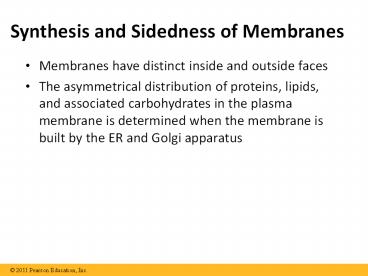Synthesis and Sidedness of Membranes - PowerPoint PPT Presentation
Title:
Synthesis and Sidedness of Membranes
Description:
Synthesis and Sidedness of Membranes Membranes have distinct inside and outside faces The asymmetrical distribution of proteins, lipids, and associated carbohydrates ... – PowerPoint PPT presentation
Number of Views:344
Avg rating:3.0/5.0
Title: Synthesis and Sidedness of Membranes
1
Synthesis and Sidedness of Membranes
- Membranes have distinct inside and outside faces
- The asymmetrical distribution of proteins,
lipids, and associated carbohydrates in the
plasma membrane is determined when the membrane
is built by the ER and Golgi apparatus
2
Figure 7.12
Secretoryprotein
Transmembraneglycoproteins
Golgiapparatus
Vesicle
ER
ER lumen
Glycolipid
Plasma membrane
Cytoplasmic face
Transmembraneglycoprotein
Extracellular face
Secretedprotein
Membraneglycolipid
3
Concept 7.2 Membrane structure results in
selective permeability
- A cell must exchange materials with its
surroundings, a process controlled by the plasma
membrane - Plasma membranes are selectively permeable,
regulating the cells molecular traffic
4
The Permeability of the Lipid Bilayer
- Hydrophobic (nonpolar) molecules, such as
hydrocarbons, can dissolve in the lipid bilayer
and pass through the membrane rapidly - Polar molecules, such as sugars, do not cross the
membrane easily
5
Transport Proteins
- Transport proteins allow passage of hydrophilic
substances across the membrane - Some transport proteins, called channel proteins,
have a hydrophilic channel that certain molecules
or ions can use as a tunnel - Channel proteins called aquaporins facilitate the
passage of water
6
- Other transport proteins, called carrier
proteins, bind to molecules and change shape to
shuttle them across the membrane - A transport protein is specific for the substance
it moves
7
Passive transport is diffusion of a substance
across a membrane with no energy investment
- Diffusion is tendency for molecules to spread out
evenly into the available space - Although each molecule moves randomly, diffusion
of a population of molecules may be directional - At dynamic equilibrium, as many molecules cross
the membrane in one direction as in the other
8
Figure 7.13
Molecules of dye
Membrane (cross section)
WATER
Net diffusion
Net diffusion
Equilibrium
(a) Diffusion of one solute
Net diffusion
Net diffusion
Equilibrium
Net diffusion
Net diffusion
Equilibrium
(b) Diffusion of two solutes
9
Figure 7.13a
Molecules of dye
Membrane (cross section)
WATER
Net diffusion
Net diffusion
Equilibrium
(a) Diffusion of one solute
10
Figure 7.13b
Net diffusion
Net diffusion
Equilibrium
Net diffusion
Net diffusion
Equilibrium
(b) Diffusion of two solutes
11
- Substances diffuse down their concentration
gradient, the region along which the density of a
chemical substance increases or decreases - No work must be done to move substances down the
concentration gradient - The diffusion of a substance across a biological
membrane is passive transport because no energy
is expended by the cell to make it happen
12
Effects of Osmosis on Water Balance
- Osmosis is the diffusion of water across a
selectively permeable membrane - Water diffuses across a membrane from the region
of lower solute concentration to the region of
higher solute concentration until the solute
concentration is equal on both sides
13
Figure 7.14
Lowerconcentrationof solute (sugar)
Higher concentrationof solute
Same concentrationof solute
Sugarmolecule
H2O
Selectivelypermeablemembrane
Osmosis
14
Water Balance of Cells Without Walls
- Tonicity is the ability of a surrounding solution
to cause a cell to gain or lose water - Isotonic solution Solute concentration is the
same as that inside the cell no net water
movement across the plasma membrane - Hypertonic solution Solute concentration is
greater than that inside the cell cell loses
water - Hypotonic solution Solute concentration is less
than that inside the cell cell gains water
15
Figure 7.15
Isotonicsolution
Hypertonicsolution
Hypotonicsolution
(a) Animal cell
H2O
H2O
H2O
H2O
Lysed
Normal
Shriveled
Cell wall
H2O
H2O
H2O
H2O
(b) Plant cell
Turgid (normal)
Flaccid
Plasmolyzed
Osmosis
16
- Hypertonic or hypotonic environments create
osmotic problems for organisms - Osmoregulation, the control of solute
concentrations and water balance, is a necessary
adaptation for life in such environments - The protist Paramecium, which is hypertonic to
its pond water environment, has a contractile
vacuole that acts as a pump
17
Figure 7.16
50 ?m
Contractile vacuole
18
Water Balance of Cells with Walls
- Cell walls help maintain water balance
- A plant cell in a hypotonic solution swells until
the wall opposes uptake the cell is now turgid
(firm) - If a plant cell and its surroundings are
isotonic, there is no net movement of water into
the cell the cell becomes flaccid (limp), and
the plant may wilt
19
- In a hypertonic environment, plant cells lose
water eventually, the membrane pulls away from
the wall, a usually lethal effect called
plasmolysis
20
Facilitated Diffusion Passive Transport Aided by
Proteins
- Facilitated diffusion, transport proteins speed
passive movement of molecules across plasma
membrane - Channel proteins provide corridors that allow a
specific molecule or ion to cross membrane - Channel proteins include
- Aquaporins, for facilitated diffusion of water
- Ion channels that open or close in response to a
stimulus (gated channels)

